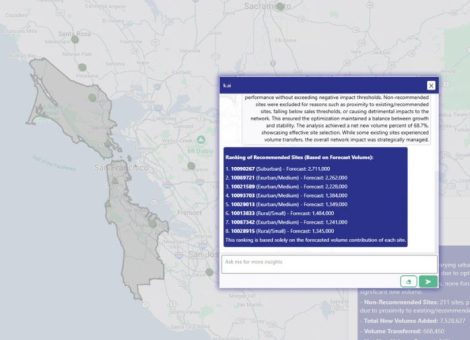Canadian 2022 National Retail Petroleum Site Census — Executive summary
The 2022 National Retail Petroleum Site Census, researched and published by Kalibrate Canada Inc. is a comprehensive enumeration of Canada’s petroleum retail outlet population. This is a unique study: there is no other single industry or governmental source of such information.
As of December 31st, 2022, 11,893 retail gasoline stations were operating in Canada or 3.1 outlets for every 10,000 persons. This is a decrease of 41 sites over last year’s survey result. The number of retail sites in Canada has fluctuated little during the last decade, hovering near the 12,000 mark since 2008 after having contracted nearly forty percent during the prior two decades.
Download a PDF format version of the executive summary here.
The Canadian Gas Station
Our census documented 97 distinct fuel brands in Canada, with the most common gas station being Esso branded, appearing at nearly 2,000 sites or 17 percent of all sites. We identified 65 distinct companies marketing gasoline in Canada, with the most common station marketed by a company virtually unknown to the average Canadian consumer, Parkland Fuel Corporation, with roughly 2,100 sites in their fuel network or 18 percent of all sites.
Most commonly, a gas station in Canada was marketed by a non-refining traditional fuel marketer at roughly 4,600 sites or 39 percent of all sites. A traditional fuel marketer is one whose primary offering is petroleum in nature and usually operates a chain of gas stations under their own brand. However, this is changing as the number of sites marketed by a non-traditional fuel marketer, one whose primary offering is something other than fuel, such as groceries or convenience store products, has increased and now makeup over a quarter of Canada’s sites.
In addition, although most traditional fuel marketers use one of their own brands in their network, these marketers are increasingly using a branded supply agreement with another brand owner (often a refiner such as Shell or Esso) to benefit from the brand recognition, proprietary fuel additives, marketing support, and loyalty programs of the established brand. In 2022, 43 percent of sites used such an arrangement, up from 38 percent the year before.
Do big oil companies control the pump price at Canadian gas stations? Refined products sold in Canada originate primarily from just 13 gasoline-producing refineries, operated by eight refining organizations, of which only five are integrated refiner marketers – selling fuel to end-users at Canadian gas stations. In 2022, integrated refiner marketers set the pump price at just nearly 2,600 gas stations or 22 percent of stations. The majority of stations have the pump price set by dealers or non-refiner marketers at 78 percent of sites.
Outlet Features and Offerings
The provision of goods or services other than gasoline is vital to the competitiveness and viability of retail gasoline outlets. Research has shown that the gross margin on gasoline itself is rarely sufficient to provide for the operating costs and reasonable return on the operation of these facilities. Accordingly, we also measured the market representation of several site features and offerings.
Our research shows that in 2022, 82 percent of Canadian gasoline stations had a convenience store, that is, a convenience store greater than 500 square feet in size. There has been a shift in convenience store size in recent years, with the most common now being a mid-size convenience store (less than 1,500 square feet) rather than a larger store. This is likely to accommodate other back-court offerings such as quick-serve restaurants or carwashes, which have increased in number.
Although most Canadian gasoline stations do not have a carwash or quick-serve restaurant, our research shows this is changing. There is now a carwash at one of every four sites and a quick-serve restaurant at nearly every one in six gasoline stations. Compared to our first survey year in 2004, there are now over 500 more carwashes and almost 900 more quick-serve restaurants at Canadian gasoline stations.
In contrast, service bays appear at only one in every 17 gasoline stations, down from one in every seven sites eighteen years earlier, our first survey year. Another trend in decline is offering full-serve pumping. In 2022, only 11 percent of the sites provided full service compared to 36 percent in 2004. Although not declining, the number of Canadian sites offering diesel fuel appears to have plateaued, changing little in the last five years. In 2022, diesel as available at roughly every three out of four gasoline stations.
Lower average site throughputs at gasoline stations during the last three years have put greater emphasis on ancillary site offerings at gasoline stations to maintain profitability. In 2020, there was a significant decline in petroleum demand due to travel restrictions introduced to curb the spread of the COVID-19 virus. Consequently, after steadily climbing for the last three decades, the average site throughput at Canadian sites in 2020 declined by an astounding 15 percent. Although restrictions eased somewhat in 2021 and 2022, the average site throughput at Canadian gas stations has not returned to pre-pandemic levels, averaging 3.4 million annual litres in 2022, ten percent below 2019.
For unrivaled insight into the Canadian petroleum retail market, purchase the full report.
Read more articles about:
Fuel pricingSubscribe and get the latest updates
You may unsubscribe from our mailing list at any time. To understand how and why we process your data, please see our Privacy & Cookies Policy
Related posts
Location intelligence
AI in location intelligence: The force multiplier for smarter site selection
AI is rapidly advancing in the world of real estate - this is the first blog in a two-part series on incorporating AI...

Meet the Kalibrate team
Delivering the Kalibrate Standard: Elizabeth Butler
This blog series explores how members of our team help our clients answer their most challenging questions. Here, we...


